

The simulations on the right are from Mr. T. Ikemura and show Mars as it was expected to be seen at the date and time indicated. I am indebted to Mr. Ikemura for permission to use these images. Mr. Ikemura's images are shown with north at the top. Most of my images are not exactly north at the top; generally they are rotated through a small angle.
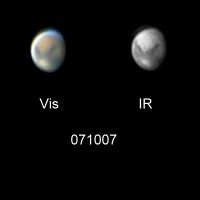
My first image of Mars for the new season. This picture was taken 1 hour before sunrise with Mars at an altitude of 61° and 138 million km (0.93 AU) away when it subtended an angle of 10 seconds of arc. The planet was 87% illuminated (as seen from Earth) which is almost as small as it can get, and the gibbous appearance can be seen in the picture.
Date and Time: 7th October 2007 at 04:49 (vis) and 05:04 (IR) UT
Camera: ToUcam 740K
Telescope: LX200 with X2 lens.
Capture: K3CCDTools.
Visible image: Low gamma, high saturation, 1/25", 37% gain, 487 frames.
IR image: Low gamma, 1/25", 37% gain, 748 frames.
Processing: Registax.
Visible image: 172 frames stacked. Wavelets 1-2 = 10.
IR image: 448 frames stacked. Wavelets 1-2 = 10, contrast 160.
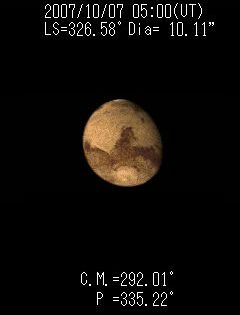
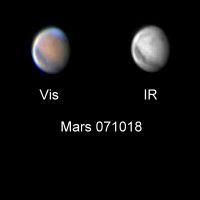
Almost 2 weeks later, this picture was taken 1½ hours before sunrise with Mars also at an altitude of 61° It was 128 million km (0.86 AU) away and subtended an angle of 11 arc-seconds. The phase had increased slightly to 88%.
Date and Time: 18th October 2007 at 04:57 (vis) and 04:51 (IR) UT
Camera: ToUcam 740K
Telescope: LX200 with X2 lens.
Capture: K3CCDTools.
Visible image: Low gamma, high saturation, 1/33", 0% gain, 454 frames.
IR image: 456 frames.
Processing: Registax.
Visible image: 180 frames stacked. Wavelets 1-2 = 10, histogram 15-185.
IR image: 357 frames stacked. Wavelets 1-2 = 10, histogram 0-155.
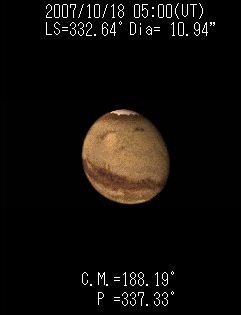
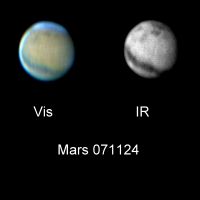
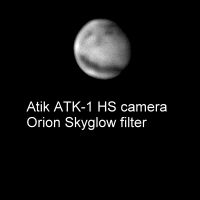
Over a month later, this picture was taken 3 hours before sunrise with Mars again at an altitude of 61°. It was 97 million km (0.65 AU) away and subtended an angle of 14 arc-seconds. The phase had increased to 95%, so we see almost the whole disc.
The lower image was made using my raw-modified monochrome camera and an Orion Skyglow filter. It was taken about an hour after the IR image above, and the rotation of Mars during that period can be seen. Otherwise, the similarity of the two images is interesting as the Orion filter blocks most of the red end of the spectrum.
Date and Time: 24th November 2007 at 02:03 (vis) and 02:25 (IR) UT
Camera: ToUcam 740K
Telescope: LX200 with X2 lens.
Capture: K3CCDTools.
Visible image: Low gamma, high saturation, 1/33", 0% gain, 454 frames.
IR image: 456 frames.
Processing: Registax.
Visible image: 180 frames stacked. Wavelets 1-2 = 10, histogram 15-185.
IR image: 357 frames stacked. Wavelets 1-3 = 10, histogram 90-150.
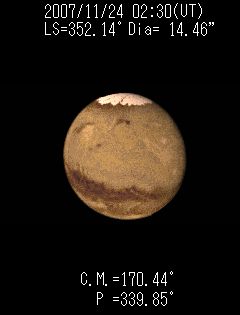
Home Back to Mars